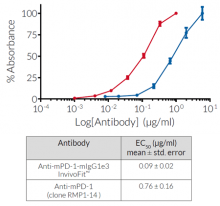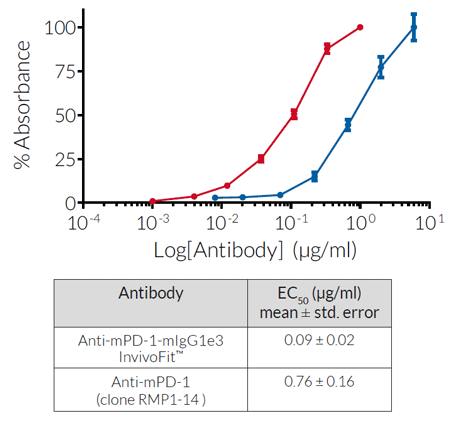Recombinant anti-mouse PD-1 antibody - Clone RMP1-14 (D265A)
| Product | Unit size | Cat. code | Docs. | Qty. | Price | |
|---|---|---|---|---|---|---|
|
Anti-mPD-1-mIgG1e3 InvivoFit™ Recombinant mAb against mouse PD-1 (clone RMP1-14), D265A effectorless. For in vivo use |
Show product |
1 mg 10 mg 50 mg |
mpd1-mab15-1
|
|

InvivoGen’s engineered
Anti-mPD-1-mIgG1e3 InvivoFit™ antibody
Recombinant murinized PD-1 antibody for in vivo use
Anti-mPD-1-mIgG1e3 InvivoFit™ is a recombinant murinized anti-mouse monoclonal antibody (mAb) featuring the variable region of the previously described anti-mPD-1 RMP1-14 mAb [1, 2]. The original RMP1-14 hybridoma was obtained by immunizing rats with cells expressing murine programmed cell death 1 (mPD-1; also known as CD279). The use of xenogeneic sequences (i.e. rat origin) for mAbs renders them immunogenic upon injection in mice [3]. Moreover, special attention should be paid to mAbs targeting the PD-1/PD-L1 axis, as repeated injections of xenogeneic anti-PD-1 or anti-PD-L1 in tumor-bearing mice were shown to induce fatal hypersensitivity reactions [4]. To overcome this issue, Anti-mPD-1-mIgG1e3 InvivoFit™ was generated by recombinant DNA technology so that it is ~65% murine. It contains the constant region of mouse IgG1 with a D265A point mutation (replacement of aspartic acid by alanine at position 265) resulting in the complete loss of unwanted Fc-associated effector functions [2, 5].
Anti-mPD-1-mIgG1e3 is provided in an InvivoFit™ grade, a high-quality standard specifically adapted to in vivo studies.
Key features of Anti-mPD-1-mIgG1e3 InvivoFit™:
- Derives from the RMP1-14 clone, rat IgG2a,κ
- Features mouse IgG1e3 isotype (constant region)
- mIgG1e3 (IgG1 with a D265A point mutation) is effectorless
- Blocks the murine PD-1 receptor without causing T cell depletion
- Filter-sterilized (0.2 µm), endotoxin level < 1 EU/mg
- Specifically designed for in vivo studies in mice
- Low aggregation < 5%
- Produced in animal-free facilities and defined media
Anti-mPD -1-mIgG1e3 InvivoFit™ is produced in Chinese hamster ovary (CHO) cells, purified by affinity chromatography with protein A, and its binding is validated by flow cytometry and ELISA.
References:
1. Ribas A. & Wolchock J.D., 2018. Cancer immunotherapy using checkpoint blockade. Science. 359:1350-55.
2. Yamazaki T. et al.,2005. Blockade of B7-H1 on macrophages suppresses CD4+ T cell proliferation by augmenting IFN-gamma-induced nitric oxide production. J Immunol. 175(3):1586-92.
3. Brüggemann M. et al., 1989. The immunogenicity of chimeric antibodies. J. Exp. Med. 170:2153-2157.
4. Mall C. et al., 2016. Repeated PD-1/PD-L1 monoclonal antibody administration induces fatal xenogeneic hypersensitivity reactions in a murine model of breast cancer. Oncoimmunology. 5(2):e1075114.
5. Baudino L. et al., 2008. Crucial role of aspartic acid at position 265 in the CH2 domain for murine IgG2a and IgG2b Fc-associated effector functions. J. Immunol. 181(9):6664-9.
Specifications
Specificity: Targets cells expressing murine PD-1
Formulation: Lyophilized from 0.2 μm filtered solution in 150 mM sodium chloride, 20 mM sodium phosphate buffer with 5% saccharose
Clonality: Monoclonal antibody
Isotype: Murine IgG1e3 (D265A mutation; no effector function), kappa
Control: mIgG1e3 InvivoFit™ isotype control
Source: CHO cells
Purity: Purified by affinity chromatography with protein A
Tested applications: Flow cytometry and ELISA
Quality control:
- Binding confirmed by flow cytometry
- The complete sequence of this antibody has been verified
- < 5% aggregates (confirmed by size exclusion chromatography)
- Endotoxin level <1 EU/mg (determined by the LAL assay)
Contents
Anti-mPD-1-mIgG1e3 InvivoFit™ is filter-sterilized (0.2 µm), endotoxin-free, azide-free, and lyophilized.
This product is available in three pack sizes:
- mpd1-mab15-1: 1 mg
- mpd1-mab15-10: 10 mg
- mpd1-mab15-50: 50 mg (5 x 10 mg)
![]() The product is shipped at room temperature.
The product is shipped at room temperature.
![]() Store lyophilized antibody at -20 °C.
Store lyophilized antibody at -20 °C.
![]() Lyophilized product is stable for at least 1 year
Lyophilized product is stable for at least 1 year
![]() Avoid repeated freeze-thaw cycles.
Avoid repeated freeze-thaw cycles.
InvivoFit™
InvivoFit™ is a high-quality standard specifically adapted for in vivo studies. InvivoFit™ products are filter-sterilized (0.2 µm) and filled under strict aseptic conditions in a clean room. The level of bacterial contaminants (endotoxins and lipoproteins) in each lot is verified using a LAL assay and a TLR2 and TLR4 reporter assay.
Back to the topDetails
Programmed cell death 1 (PD-1; also known as CD279) is a type I transmembrane protein expressed at the cell surface of activated and exhausted conventional T cells. PD-1 is an inhibitory immune checkpoint that prevents T-cell overstimulation and host damage.
PD-1 interaction with its ligands PD-L1 (programmed cell death ligand 1) or PD-L2 induces inhibition of T-cell receptor signaling. Blockade of PD-1 with mAbs has allowed unprecedented remissions in patients with metastatic melanoma or non-small cell lung cancer.





 BULK QUANTITY:
BULK QUANTITY:
